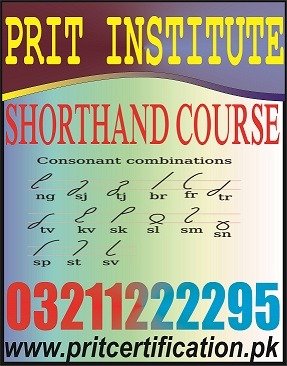Shorthand Course In Rawalpindi Islamabad Gujrat Gujranwala
- Your Name: waseem
- Contact Number: 03211222295
- Address: isb
- Select Your City: Islamabad
- Listed:
- Expires: This ad has expired
Description
Shorthand Course In Rawalpindi Islamabad Gujrat Gujranwala
The earliest known indication of shorthand systems is from the Parthenon in Ancient Greece, where a mid-4th century BC marble slab was found. This shows a writing system primarily based on vowels, using indicate.consonants.citation needed Hellenistic tachygraphy is reported from the 2nd century BC onwards, though there are indications that it might be older. The oldest datable reference is a contract from Middle Egypt, stating that Oxyrhynchos gives the semeiographer Apollonios for two years to be taught shorthand writing. Hellenistic tachygraphy consisted of word stem signs and word ending signs. Over time, many syllabic signs were developed. In Ancient Rome, Marcus Tullius Tiro (103–4 BC), a slave and later a freedman of Cicero, developed the Tironian notes so that he could write down Cicero’s speeches. Plutarch (c. 46 – c. 120 AD) in his Life of Cato the Younger (95–46 BC) records that Cicero, during a trial of some insurrectionists in the senate, employed several expert rapid writers, whom he had taught to make figures comprising numerous words in a few short strokes, to preserve Cato’s speech on this occasion. The Tironian notes consisted of Latin word stem abbreviations (notae) and of word ending abbreviations (titulae). The original Tironian notes consisted of about 4000 signs, but new signs were introduced, so that their number might increase to as many as 13,000. In order to have a less complex writing system, a syllabic shorthand script was sometimes used. After the decline of the Roman Empire, the Tironian notes were no longer used to transcribe speeches, though they were still known and taught, particularly during the Carolingian Renaissance. After the 11th century, however, they were mostly forgotten.When many monastery libraries were secularized in the course of the 16th-century Protestant Reformation, long-forgotten manuscripts of Tironian notes were rediscovered.Shorthand Course In Rawalpindi, Islamabad, Lahore, Karachi, Gilgit, Skardu, Ghangche, taxila, Shigar, Astore, Diamer, Ghizer, Kharmang, Gultari, Rondo, Hunza Nagar, Gupi, Azad Jammu and Kashmir, Muzaffarabad, Mirpur, Bhimber, Kotli, Rawlakot, Bagh, Bahawalpur, Bhakkar, Chakwal, Chiniot, Dera Ghazi Khan, Faisalabad, Gujranwala, Gujrat, Hafizabad, Jhang, Jhelum, Kasur, Khanewal, Khushab, Layyah, Lodharan, Mandi-Bahuddin, Mianwali, Multan, Muzaffargarh, Nankana Sahib, Narowal, Okara, Pakpattan, Rahim Yar Khan, Rajanpur, Sahiwal, Sargodha, Sheikhupura, Sialkot, Toba tek Singh, Vehari, Attock, Taxila, Wah Cantt, Rawalpindi, Balochistan, Khyber-Pakhtunkhwa, Punjab, Sindh, Gilgit Baltistan, Turbat, Sibi, Chaman, Lasbela, Zhob, Gwadar, Nasiraba, Jaffarabad, Hub, Dera Murad Jamali, Dera Allah Yar, Khyber-Pakhtunkhwa, Peshawar, Mardan, Abbottabad, Mingor, Kohat, Bannu, Swabi, Dera Ismail Khan, Charsadda, Nowshera, Mansehra, Hyderabad, Sukkur, Larkana, Nawabshah, Nanak wara, Mirpur Khas, Jacobabad, Shikarpur,


